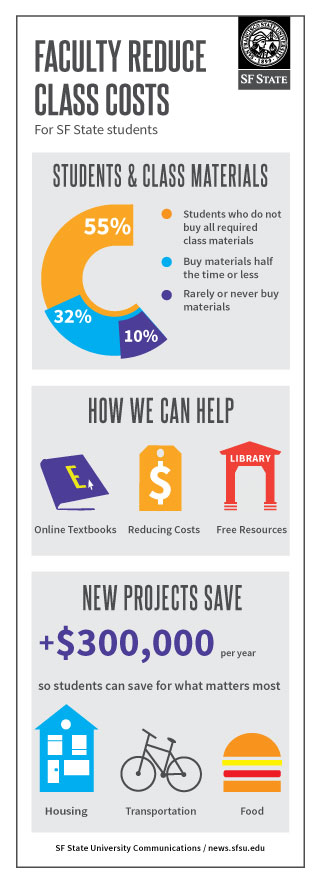Book smart: Faculty proposals to save students more than $300,000 a year
Heavy, expensive textbooks are the bane of most students' back-to-school shopping lists. But SF State students will save more than $300,000 per year -- and countless trees will be spared -- based on new faculty proposals that will provide alternatives to costly textbooks.
 Supported by the California State University's system-wide "INFOGRAPHIC: Faculty reduce class costs for SF State students. Students & Class Materials: 55% of students do not buy all required class materials, 32% buy materials half of the time or less and 10% rarely or never buy materials. How we can help: online textbooks, reducing costs and free resources. New projects save more than $300,000 per year, so students can save for what matters most (housing, transportation and food).Affordable Learning Solutions" initiative, five faculty members or teams have received stipends to pursue cost-saving projects that are both eco- and budget-friendly.
Supported by the California State University's system-wide "INFOGRAPHIC: Faculty reduce class costs for SF State students. Students & Class Materials: 55% of students do not buy all required class materials, 32% buy materials half of the time or less and 10% rarely or never buy materials. How we can help: online textbooks, reducing costs and free resources. New projects save more than $300,000 per year, so students can save for what matters most (housing, transportation and food).Affordable Learning Solutions" initiative, five faculty members or teams have received stipends to pursue cost-saving projects that are both eco- and budget-friendly.
"We've calculated that if every student in every class bought all the required materials at list price it would add up to roughly $15 million per semester," said Brian Beatty, leader of SF State's Affordable Instructional Materials (AIM) team, which allocated the stipends. "Our hope is that if we can reduce costs for students they will have better access to materials so they can pass their classes and graduate faster."
Since faculty members decide what materials are used in their classes, Beatty said, SF State's AIM team came up with the idea of offering awards to motivate them to consider ways to cut down on course-material costs. "This is something that is not that difficult for a lot of faculty to do, but it's not at the top of the mind for most," said Beatty, associate vice president for academic affairs operations.
The School of Public Affairs and Civic Engagement (PACE) proposed the project with the biggest monetary impact. PACE was awarded support to explore decreasing costs for 21 courses with materials that currently cost more than $100, with the goal of lowering the average cost to less than $75. The projected savings to students? A whopping $100,000 per semester.
"In PACE, we're all departments that address larger issues of inequality, so we are very attuned to the fact that many students are first-generation college students or come from low-income communities," said Elizabeth Brown, chair of the department of Criminal Justice Studies and PACE's director. "We know that the costs of tuition and textbooks are increasing, and we don't want those costs to be a barrier to education for our students."
In the English department, faculty members are implementing a free online replacement for a required $22 text used in a first-year composition course taken by the majority of freshmen -- about 3,800 students each year -- for a total projected annual savings of approximately $80,000.
"Although the book is relatively inexpensive, the composition program is very mindful of the costs of materials, so we've decided to take the book online and host it as a free resource for our students," said Tara Lockhart, director of the composition program.
Rounding out the successful faculty proposals, Associate Professor of Economics Anoshua Chaudhuri and Associate Professor of Africana Studies Dawn-Elissa Fischer are looking into ways to replace required course materials with free resources available in the library or online, saving each student an estimated $90 to $150. Assistant Professor of Education Patricia Donohue is working to provide free access to required materials for courses in the instructional technologies program, such as e-book readers and smart pens, for a total savings of $5,000 a year.
The AIM team is also coordinating with other campus entities to find ways to reduce course-material costs, Beatty said. This semester, for example, the J. Paul Leonard Library and SFSU Bookstore have partnered for the first time to identify and publish a list of 300 frequently used textbooks that are available through the library as free e-books.
In addition, Beatty's team is analyzing data from a recent student survey about textbook-purchasing habits. Based on similar surveys at other universities, Beatty said, they expect to find that students choose not to buy certain textbooks because they are too expensive -- which can have negative effects on academic performance.
"Faculty may be adopting a $150 textbook and thinking that all their students are buying it, but they aren't," Beatty said. "We want to show the pervasive nature of students opting out. Our ultimate goal is to increase students' academic success, and keeping education costs affordable is one way to do that."
Faculty will have future opportunities to apply for stipends for projects that reduce course-material costs. For more information, visit http://affordablelearning.sfsu.edu or contact affordablesfsu@lists.sfsu.edu
-- Beth Tagawa